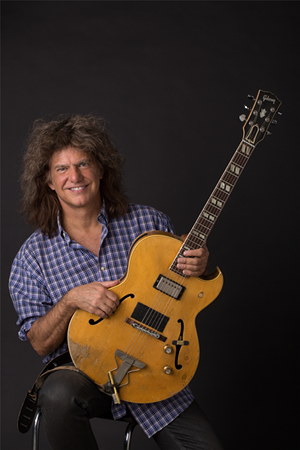Back when Jazz guitarist Pat Metheny started performing the Kansas City circuit in the early ’70s, he looked to the city’s older musicians for inspiration.
“I really learned about music on the bandstands of Kansas City with many of the best players in town of that era: Gary Sivils, Paul Smith, Tommy Ruskin, Russ Long and many others who might not be world famous but remain among the greatest musicians I have ever known,” he says in a recent email exchange. “It was on the job training for me. I was really lucky to have that experience as a young teenage kid and will forever be grateful for it.”
Metheny had the good fortune to grow up in a very musical family. His father played trumpet, his mother sang and his maternal grandfather was a professional trumpeter.
“I was lucky,” he says when asked about his upbringing. “The emphasis was on quality musicianship. And there was always a lot of great music on the stereo, so even in the middle of rural Missouri, I was exposed to really good notes.”
He got his first guitar when he was 12 and proceeded to teach himself to play.
“The good part was that since there were no teachers around, the only thing I could compare myself to were the things I was hearing on records — and compared to that I was terrible,” he says of learning how to play and developing his own voice. “So I had my work cut out for me. All of my favorite musicians had a sound. That was clearly the goal. I am still puzzled by the generation that immediately followed me. Fortunately, the generation after that one was back to it.”
Metheny launched his career with a bang. In 1974, he appeared on an album with pianist Paul Bley, bassist Jaco Pastorius and drummer Bruce Ditmas. He didn’t even know the session he played was being recorded. But he left a lasting impression and would release his debut album, Bright Size Life, in 1976.
“The foundation I had from Kansas City was the key to everything that followed (Bright Size Life),” Metheny says. “Joining Gary Burton’s band at age 18 was like joining The Beatles for me. Each step followed the next. But in the end, whatever the music has wound up being has fostered whatever happened.”
His unique improvisational style that blends “the loose and flexible articulation customarily reserved for horn players with an advanced rhythmic and harmonic sensibility,” as it’s put in his bio, quickly turned him into a sensation. There’s a vibrancy to his playing that’s apparent on Pat Metheny Group’s self-titled debut that came out in 1978. The complexity of tunes like “Phase Dance” and “Jaco,” tracks that feature the electric guitar prominently, are suggestive of his prodigious talent.
Last year, Metheny — who, over the decades, has performed with everyone from Steve Reich to Ornette Coleman to Herbie Hancock — launched Side-Eye, his project with keyboardist James Francies and drummer Marcus Gilmore.
"I continue to be a big fan of the music,” he says when asked about how he met Francies and Gilmore. “I follow the scene closely and have a pretty good idea who the best new players are as soon as they become active on the scene. The challenge for me is to find people who can play simple — it is pretty easy to find lots of people who can play some fancy stuff. Both James and Marcus fit that bill. I have known Marcus since he was a little kid — he is Roy Haynes’ grandson. And James immediately captured my interest — I don’t think there has been a James before. James is an original. Marcus is the best of everything up to this point.”
Metheny says he’s always had “a bunch of different things going musically” at any given point in his career, so Side-Eye shouldn't be seen as an anomaly.
“I have presented (music) in different guises to somehow distinguish the general musical destinations that I was going to focus on for that period,” he says. “This has generally been useful, but in truth everything I do functions in basically the same way in that I try to find the best musicians I can who I feel can help me to get to the best version of what is interesting to me at the time. In that sense, regardless of what I call it, everything is essentially the ‘Pat Metheny Group’ in that it is about coming up with a setting that is unique and inspiring and resonates with my sense of how I am hearing things at that particular moment.”
He says he always tries to “create an environment where whoever it is I choose at a particular time can also shine and get to the things that they do best.” Side-Eye continues in that tradition.
“This particular version of that platform is set up so I can draw from the best of some of the younger players around who have impressed me,” Metheny says. “Many of those musicians have grown up listening to my stuff as part of their broad interest in this music and have absorbed the details of it in a way that is really interesting to me. (Side-Eye) is a chance to explore some of the older music through that prism, and also for me to write some new things to feature the aspects of their relationship to that language that might lead to something special.
“So far, it has proven to be a total blast both looking at earlier music and also doing some of the newer things that I have written just for these players.”
Pat Metheny plays wtih Side-Eye at Over-the-Rhine's Memorial Hall this Sunday, Sept. 8. Tickets/more info: memorialhallotr.com.


